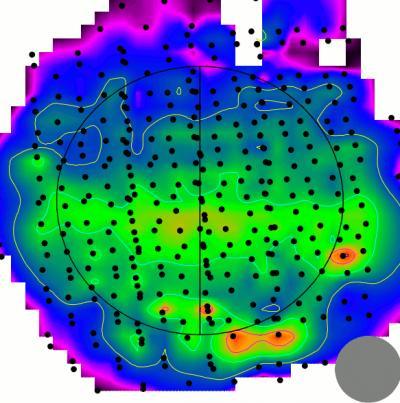On March 24th, 1993, astronomers David Levy and Carolyn and Eugene M. Shoemaker discovered the first comet observed orbiting a planet rather than the Sun. Named Shoemaker-Levy 9 (SL9), it was found to be composed of 21 fragments. Soon after that, orbital studies showed that the comet had passed within Jupiter's Roche limit in July 1992. Inside this limit, the planet's tidal forces are strong enough to disintegrate a body held together by its own gravity, thus explaining SL9's fragmentation.
Studies showed that SL9's orbit would pass within Jupiter in July 1994 and that the comet would then collide with the planet, with impacts in the southern hemisphere near 44°S latitude. And so it happened. In July 1994, Shoemaker-Levy 9 (SL9) hit Jupiter and left visible scars on the Jovian disk for weeks, our first direct observation of an extraterrestrial collision in the solar system.
The SL9 impact and its subsequent scars on Jupiter were observed for weeks, but its chemical impact on Jupiter's atmosphere lasted even longer. Emission from water vapor was observed during the fireball phase of the SL9 impacts, but from that observation, it was difficult to assess how this would modify Jupiter's composition on the long term. In 1997, the ESA Infrared Space Observatory (ISO) detected water vapor in the stratosphere of Jupiter. At that time, astronomers suspected that it might be a consequence of the SL9 impact because comets are known to be water-rich bodies. However, there were other possible sources of water: interplanetary dust particles produced by cometary activity and asteroid collisions, icy rings, or one of the 60 Jovian satellites.

The abundance of water in Jupiter's stratosphere. The north-south asymmetry is clearly observed. The green and red areas correspond to the highest abundances. Credit: Astronomy&Astrophysics, Cavalié et al. 2013, A&A, 553, A21
Nearly twenty years after this major impact, astronomers are still observing its consequences on Jupiter. T. Cavalié and his colleagues observed Jupiter with the ESA Herschel Space Observatory, which is sensitive enough to map the abundance of water vs. latitude and altitude in the Jovian stratosphere.
The newer observations published in Astronomy & Astrophysics show a clear north-south asymmetry in the distribution of water, with more water in the south. They indicate that 95% of the water currently observed on Jupiter comes from the comet.






Comments